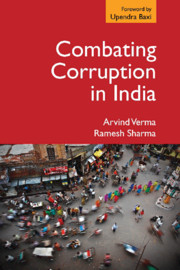Book contents
- Frontmatter
- Contents
- List of Tables and Figures
- Acknowledgements
- Foreword
- 1 Introduction
- Part I Corruption in India
- Part II Combating Corruption in India
- 4 Anti-Corruption Machinery: CVC and CBI
- 5 Evaluating Efficacy of Anti-Corruption Agency: Case Study from Madhya Pradesh
- 6 Lokpal and Lokayukta: A Critical Examination
- Part III Way Forward: Alternate Solutions
- Bibliography
- Index
4 - Anti-Corruption Machinery: CVC and CBI
from Part II - Combating Corruption in India
Published online by Cambridge University Press: 13 November 2018
- Frontmatter
- Contents
- List of Tables and Figures
- Acknowledgements
- Foreword
- 1 Introduction
- Part I Corruption in India
- Part II Combating Corruption in India
- 4 Anti-Corruption Machinery: CVC and CBI
- 5 Evaluating Efficacy of Anti-Corruption Agency: Case Study from Madhya Pradesh
- 6 Lokpal and Lokayukta: A Critical Examination
- Part III Way Forward: Alternate Solutions
- Bibliography
- Index
Summary
This chapter describes the existing anti-corruption machinery in India, both at the central and state levels, and examines in detail their functions and limitations in the country. We describe the nature, structure and role played by the CBI and the CVC. Their charters are evaluated in terms of a large number of case studies to illustrate the strengths and weaknesses of these two organizations in handling corruption in the country at the federal level. The major argument we make is that the efficacy of investigative agencies is affected due to their lack of autonomy. The political leaders and bureaucrats tightly control the funds as well as personnel in terms of their transfer, posting, promotion and disciplinary matters. These are often misused to ‘tame’ recalcitrant officers and make them fall in line to ensure that political considerations are not affected by these investigation agencies. We present strong evidence about the misuse of power of the politicians to grant approval for inquiring into or registering cases against senior bureaucrats. A number of cases are presented to illustrate how corrupt officials have thwarted attempts of investigators to inquire into their questionable activities. On the other hand, we also examine why immunity granted to the senior levels of bureaucracy, drawn from the All India Services, including the Indian Administrative Service (IAS), Indian Police Services (IPS) and Indian Foreign Service (IFS), under Article 311 of the Constitution has failed to shield them to work independent of political, bureaucratic and other pressures. We also argue that the Anti-Corruption Bureaus (ACBs) in this country are mainly concerned with the detection and prosecution of corruption and economic crimes and there is little by way of prevention in their functions. These agencies step in only when the damage is done.
Structure of Anti-Corruption Machinery
The jurisdiction and set up of the anti-corruption machinery in India is based on the mandate that ‘police’ is a state subject, being in List II Entry 2 of the Seventh Schedule of the Constitution of India and hence police agencies are distributed between the union and state governments. At the level of the union government, there are specific agencies to deal with cases of corruption under the Prevention of Corruption Act, 1988 against officers and employees of the central government. There are different anti-corruption units functioning under each state government to deal with state officers and employees.
- Type
- Chapter
- Information
- Combating Corruption in India , pp. 75 - 115Publisher: Cambridge University PressPrint publication year: 2018



